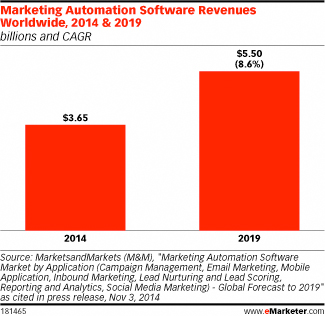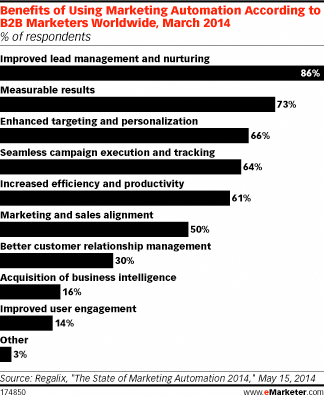What Are the Benefits of Marketing Automation?
February 7, 2015
![]() Marketing automation is still new enough and complex enough that even vendors of automation systems face challenges running their own marketing operations on their own platforms. Despite the complexity, adoption has been fairly rapid and widespread, and there is still potential for further uptake, according to a new eMarketer report, “Marketing Automation: Examining Users and Usage, and What’s Coming Next.”
Marketing automation is still new enough and complex enough that even vendors of automation systems face challenges running their own marketing operations on their own platforms. Despite the complexity, adoption has been fairly rapid and widespread, and there is still potential for further uptake, according to a new eMarketer report, “Marketing Automation: Examining Users and Usage, and What’s Coming Next.”
 Market research firm Markets and Markets estimated that marketing automation software revenues worldwide would grow to $5.50 billion in 2019, up from $3.65 billion in 2014.
Market research firm Markets and Markets estimated that marketing automation software revenues worldwide would grow to $5.50 billion in 2019, up from $3.65 billion in 2014.
The benefits of using marketing automation are numerous. Chief among them are improved lead management in the form of scoring, nurturing and segmentation, as well as email and campaign management. Experts say mastering these functions through marketing automation will enhance efficiencies and help streamline the marketing and sales process. Ultimately, once marketing automation systems are implemented and integrated into CRM platforms, measureable results and granular insights about how to engage with prospects and customers follow.
 A March 2014 study by Regalix found an overwhelming percentage of business-to-business marketers polled worldwide saw benefits from marketing automation in the area of improved lead management and lead nurturing, measureable results and enhanced targeting and personalization.
A March 2014 study by Regalix found an overwhelming percentage of business-to-business marketers polled worldwide saw benefits from marketing automation in the area of improved lead management and lead nurturing, measureable results and enhanced targeting and personalization.
Further, a global survey in October 2014 of more than 300 US marketing executives conducted by Forbes Insights and Turn, a provider of real-time data analytics products, found that marketers proactive in leveraging data-driven marketing were “three times more likely than laggards to report achieving competitive advantage in customer engagement/loyalty (74% vs. 24%) and almost three times more likely to have increased revenues (55% vs. 20%).”
Marketers also see benefits from marketing automation in being able to shorten the sales cycle and close deals more quickly.
“We’re focused on closing the deal. Shortening the sales cycle comes up, but the primary objective is ‘let’s close the deal’ and identify those prospects and customers who are a good fit for this product,” said Lawrence DiCapua, global leader of revenue marketing for GE. “Let’s nurture them to the point that they’re actually buying.”
Courtesy of eMarketer





























